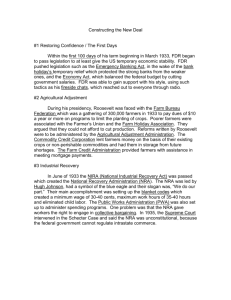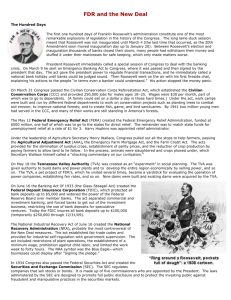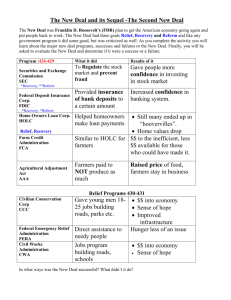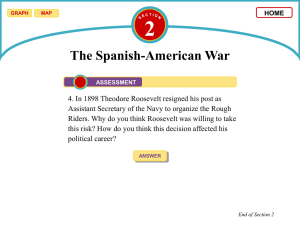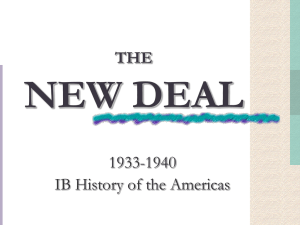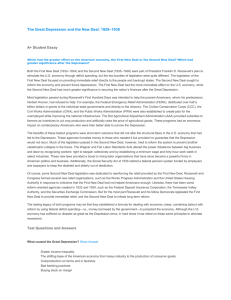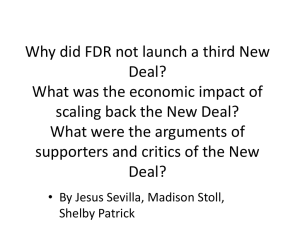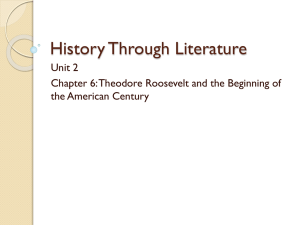Chapter 12 Section 1 The First New Deal
advertisement
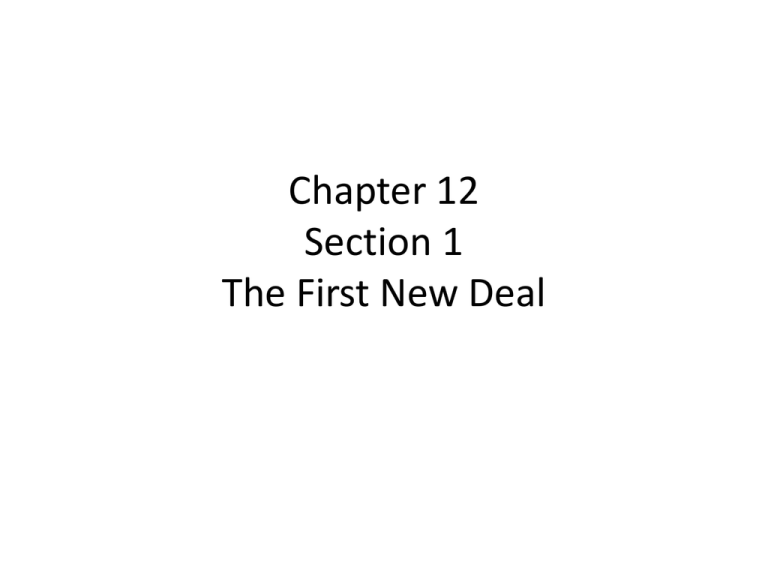
Chapter 12 Section 1 The First New Deal After FDR’s Elected • Between Roosevelt’s election (November 1932) and his inauguration (March 1933), unemployment continued to rise and bank runs increased. Gold Standard • Some people feared Roosevelt would lower the value of the dollar to fight the Depression. • Under the gold standard, one ounce of gold equaled a set number of dollars. • To lower the value of the dollar, the United States would have to stop exchanging dollars for gold. Fearing the Gold Standard • Depositors in American banks took out money. • They wanted to convert deposits to gold before the dollar lost value. – Thirty-eight state governors declared bank holidays. • They closed banks before runs could put them out of business. First 100 Days • Roosevelt began his term by sending bill after bill to Congress. • During the first three months of his administration (first 100 days), Congress passed 15 major acts to attack the economic crisis. Brain Trust • Roosevelt chose advisors with different points of view. – One group believed business and government should work together. – A second group distrusted business and wanted government to run important parts of the economy. – A third group wanted to break up companies to introduce competition. National Bank Holiday • President Roosevelt realized that one of the first things he needed to do was restore people’s confidence in the banks. • He declared a national bank holiday and then called a special session of Congress. Emergency Banking Relief Act • On the day Congress met, the House and Senate passed the Emergency Banking Relief Act. – The president signed it into law. • It said federal officials would check the nation’s banks and license those that were financially sound. Fireside chat • After becoming president, on March 12, Roosevelt addressed the nation on radio in the first of many fireside chats—talks in which he told the American people what he was trying to accomplish. • He told them it was safe to put their money back into banks. • The next day there were more deposits than withdrawals. The Securities Act of 1933 • Roosevelt’s advisors pushed for regulation of the bank industry and the stock market. • Under the Securities Act of 1933, the Securities and Exchange (SEC) was created to regulate the stock market and prevent fraud. • Companies were required to provide investors with complete and truthful information. The Glass-Steagall Banking Act • The Glass-Steagall Banking Act created the Federal Deposit Insurance Corporation (FDIC). • Under the Glass-Steagall Banking Act, commercial banks could no longer risk depositors money I by using it to speculated on the stock market. • FDIC greatly increased public confidence in the banking system by insuring bank deposits up to a set amount. HOLC • Roosevelt asked Congress to establish the Homeowners Loan Corporation to help people pay their mortgages. Helping Farmers • Congress also created the Farm Credit Administration to help farmers refinance their mortgages. • To help farmers hurt by the Depression, Roosevelt started a new farm program. • Under the program, the government paid farmers not to raise certain livestock and crops. Agricultural Adjustment Administration (AAA) • The idea behind the Agricultural Adjustment Administration was that prices for farm goods were low because farmers grew too much food. – Over the next two years, the farm surplus fell sharply. – Prices and farm income rose. • The program mostly benefited large commercial farmers who grew one crop. – Many poor tenant farmers became homeless. National Industrial Recovery Act (NIRA) • In June 1933, Roosevelt turned his attention to industry. • Congress enacted the National Industrial Recovery Act (NIRA). • It suspended antitrust laws (monoplies). • It let business, labor, and government set up voluntary rules for each industry known as codes of fair competition. The National Recovery Administration (NRA) • Some codes set prices, minimum wages, and limited factories to two shifts per day. • The National Recovery Administration (NRA) ran the program. • Participating businesses displayed signs with the NRA symbol. • NRA codes were difficult to administer and tended to favor large corporations. • By the time the Supreme Court declared the NRA unconstitutional in 1935, it had lost much of its support. Getting People Relief (money) • Some presidential advisors thought the major cause of the Depression was a lack buying power. • They supported work programs for the unemployed, which would get money into the hands of individuals. Civilian Conservation Corps (CCC) • One such relief program was the Civilian Conservation Corps (CCC). • The CCC employed young men 18 to 25 years old under the direction of the forestry service. • They planted trees, fought forest fires, and built reservoirs. • The young men lived in camps near their work areas, earning $30 per month. • The program put about 3 million people to work. Federal Emergency Relief Administration (FERA) • Congress set up the Federal Emergency Relief Administration (FERA). • FERA channeled federal money to state and local agencies to fund their relief projects. Public Works Administration (PWA) • The Public Works Administration (PWA) was a federal relief agency. • The PWA built highways, dams, sewer systems, schools, and government buildings. • It gave contracts to construction companies. • The PWA broke down racial barriers in construction trades because contractors could not discriminate against African Americans. Civil Works Administration (CWA) • The Civil Works Administration (CWA) hired workers directly and placed them on the federal payroll. • It built roads, airports, schools, playgrounds, and parks before Roosevelt ordered it shut down. Restoring Faith • Perhaps the most important result of the first New Deal was a noticeable change in the spirit of the American people. • The New Deal programs inspired hope and restored faith in the country.
